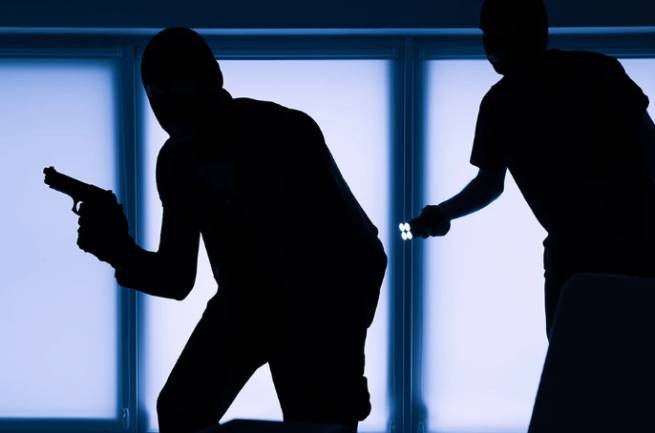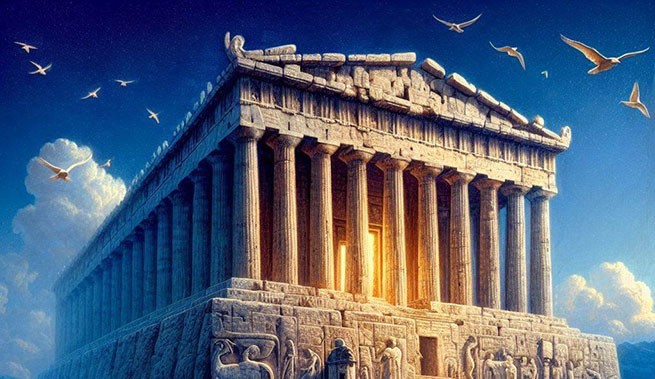The Acropolis of Athens is a rocky hill in the Greek capital that is home to the famous Parthenon Temple. It is one of the most visited and famous archaeological sites in the world.
Few people know that the attraction hides a fascinating secret. A real ancient detective story! Recently, archaeologists made an incredible discovery that helped shed light on it…
Graffiti of a shepherd-goatherd
The rock paintings were found on a marble rock outcrop at Vari. It is just a couple of tens of kilometers from Athens. The drawing that most interested scientists was very small. In total, more than 2 thousand graffiti have been found here in recent years. Some contain text, some only pictures. All images date back to the 6th century BC and were left by local goatherds.

Rock painting with a depiction of a temple and an inscription. / Photo: labrujulaverde.com
The drawing that interested the researchers was almost completely destroyed by erosion, but the writing can be made out. The unusual image includes a diagram of the temple building. It has five columns, and the pentastyle is very atypical for Greek architecture, with such rare exceptions as, for example, the Temple of Apollo at Thermos. Protruding elements and horizontal lines suggest a two-stage lining or, conversely, an entablature with acroteria. The inscription snakes around the design and consists of letters from the ancient Attic alphabet.

Reproduction of graffiti found in Vari. (Drawing by Merle Langdon) / Photo: ancient-origins.net
The mysterious inscription reads: “Hecatompedon… Mycona.” In Greek, hecatompedon means “one hundred feet” (100 feet is just over 30 meters). This enormous building once stood on the site where the Parthenon now stands. The temple was dedicated to the goddess Athena. The drawing of the shepherd Mykon is almost a hundred years older than the Parthenon, whose construction began around 450 BC.

The location of the find is indicated by a red arrow. / Photo: labrujulaverde.com
Lost Ancient Greek Temple
It turns out that the ancient Parthenon is not the first majestic temple on this site. Archaeologists assumed that even more ancient temples were located here, but found no evidence. What these sacred structures looked like, when they were erected and where exactly they were located – all this, until recently, was the subject of heated debate. It is quite difficult to find out all these aspects, because in 480 BC, during the Greco-Persian Wars, the Persian army arrived in Athens and destroyed all the buildings that then stood on the Acropolis.
In fact, the Acropolis Museum in Athens is a repository of ruins and fragments of statues. Once upon a time, all this was part of temple decorations. Everything was destroyed by the Persians. Now scientists are interested in the question: could one of the lost temples be the Hekatompedon painted by Micon?
The graffiti of the shepherd Mikon lifted the veil of secrecy
The most interesting thing about this mysterious predecessor of the Parthenon is the mention of its name in the ancient Greek democratic decree. The document dates from before the Persian attack and the construction of the Parthenon. Its text says that the Hekatompedon is a place for storing treasures.

Details of the inscription about Hekatompedon. / Photo: labrujulaverde.com
Some scholars say that the Hekatompedon mentioned in the decree was a temple, since Greek temples usually served as a repository for treasures dedicated to the gods. Other researchers insist that the word “Hecatompedon” may not refer to the temple at all and perhaps means the open courtyard on the Acropolis.

Detail of the inscription with the signature Μίκōνος. / Photo: labrujulaverde.com
Only the recently discovered graffiti of the shepherd Mykon helped scientists understand this ancient mystery. Micon called his painted temple Hekatompedon. This means that the term “Hecatompedon” in the decree referred specifically to the temple. Even the Parthenon standing on the hill today was once called Hekatompedon. Of course, the temple depicted by Micon is long gone, but most likely, some of the temple sculptures in the museum belong to him, since it once stood on the spot where the Parthenon stands today.

Acropolis Museum in Athens. / Photo: ancient-origins.net
In addition to all of the above, the graffiti found is also important because it indicates that, contrary to popular belief, shepherds were not illiterate in those ancient times. Many rock paintings and inscriptions indicate that these people were quite educated, at least they knew how to read and write. The drawings obviously helped them while away the endlessly boring hours of their work.
So the inscriptions, once made by shepherds out of boredom, became the key to unraveling the historical mysteries of one of the most iconic archaeological sites in the world.
Source: kulturologia.ru







More Stories
Ecumenical Patriarch Bartholomew became an honorary citizen of Kilkis (video)
Sophia Loren celebrated her 90th birthday with a party in Rome
Antique Vase Returns to Greece from Italy